Morphology Of Cell Injury Important Notes
1. Types of necrosis

2. Types of degeneration
- Cloudy swelling – a most common type
- Hydropic
- Hyaline
- Mucoid degeneration
3. Morphological forms of cell injury
- Reversible
- Cellular Swelling
- Fatty change
- Hyaline change
- Mucoid change
- Irreversible
- Apoptosis
- Autolysis
- Necrosis
4. Apoptosis
- Apoptosis is physiological or programmed cell death
- It eliminates cells that are genetically altered or injured beyond repair without eliciting a severe host reaction
- It prevents the development of epithelial dysplasia by programmed cell death
- It is usually single-cell death and undergoes coagulative necrosis.
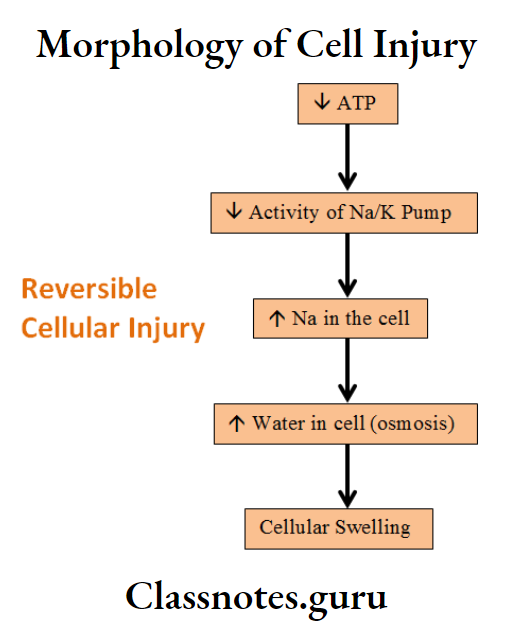
Morphology Of Cell Injury Long Essays
Question 1. Classify necrosis. Discuss its nuclear changes.
Answer:
Necrosis Classification:
Necrosis is classified into the following types:
1. Coagulative necrosis
- Caused by irreversible focal injury
2. Liquefaction necrosis
- Occurs due to ischaemic injury and bacterial or fungal infections
Read And Learn More: Pathology Question And Answers
3. Caseous necrosis
- Found in the center of foci of tuberculous infections
4. Fat necrosis
- Occurs at two anatomically different locations
5. Fibrinoid necrosis
- Deposition of fibrin-like material occurs
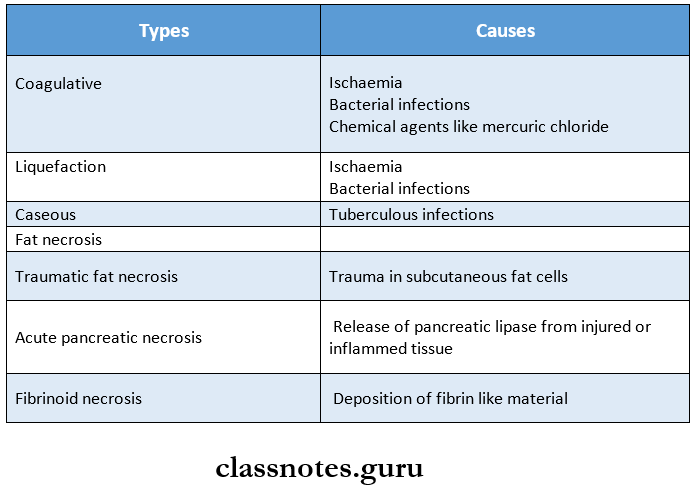
Nuclear Changes In Necrosis:
1. Pyknosis
- It is a condensation of nuclear chromatin
2. Karyolysis
- Undergo dissolution
3. Karyorrhexis
- Fragmentation
Question 2. Define necrosis. Classify and discuss different types of necrosis.
(or)
Define necrosis. Discuss etiopathogenesis and morphology of various types of necrosis.
Answer:
Definition:
Necrosis is defined as a localized area of death of tissue followed by degradation of tissue by hydrolytic enzymes liberated from dead cells, it is invariably accompanied by an inflammatory reaction
Necrosis Types:
There are five types of necrosis
1. Coagulative necrosis
- Causes:
- Ischaemia
- Bacterial infection
- Chemical agents like mercuric chloride
- Pathogenesis
- Irreversible cell injury
- Results in sudden cessation of blood flow
2. Liquefaction necrosis
- Causes:
- Ischaemia
- Bacterial infections
- Pathogenesis
- Bacterial and fungal infections produce hydro-lytic enzymes
- This causes the degradation of tissue
3. Caseous necrosis
- Occurs in the center of foci of Tuberculous infections
4. Fat necrosis
- Occurs at two anatomically different locations
- Types
- Acute pancreatic necrosis
- Traumatic fat necrosis
5. Fibrinoid necrosis
- Deposition of fibrin-like material occurs
Morphology of types of Necrosis:

Question 3. Define and classify gangrene. Write the differences between dry and wet gangrene
Answer:
Definition:
- Gangrene is a form of necrosis of tissue with superadded putrefaction
Gangrene Classification:
- Gangrene is classified into two main types
- Dry gangrene
- Wet gangrene
Difference Between Dry and Wet Gangrene:
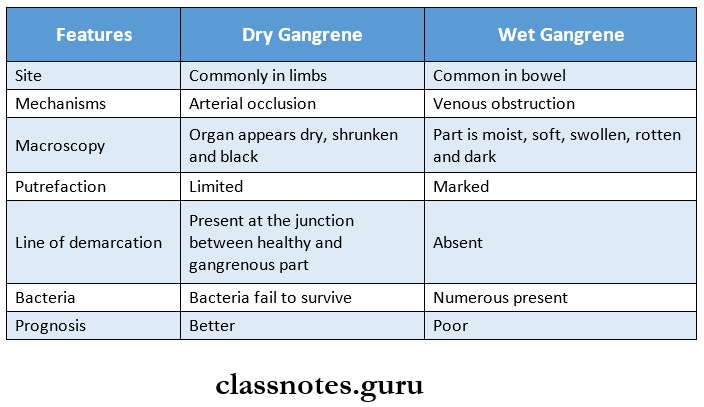
Question 4. Write about wet gangrene.
Answer:
Wet Gangrene:
Wet gangrene usually occurs in moist tissues and organs
Site Involved:
- Mouth
- Bowel
- Lung
- Cervix
- Vulva
Wet Gangrene Cause:
- Venous blockage
Wet Gangrene Pathogenesis:
- The affected part is filled with blood
- It favors the rapid growth of Putrefaction bacteria
- Formation of toxic products by bacteria
- Absorption of toxic products
- Causes septicemia
- Finally causes death
Wet Gangrene Features:
1. Gross features
- The affected part appears soft, swollen, putrid, rotten, and dark
- Part is stained dark
2. Microscopic features
- Coagulative necrosis is seen
- There is ulceration of the mucosa and intense inflammatory infiltration
- Lumen shows mucus and blood
- There is no line of demarcation present.
Morphology Of Cell Injury Short Essays
Question 1. Types of necrosis with examples
Answer:
Types of Necrosis:

Question 2. Dry gangrene
Answer:
Gangrene:
- Gangrene is a form of necrosis of tissue with super-added putrefaction
Dry Gangrene:
- It is a form of gangrene occurring due to Ischaemia
Dry Gangrene Causes:
- Ischaemia
- Atherosclerosis
- Buerger’s disease
- Raynaud’s disease
- Trauma
- Ergot poisoning
Dry Gangrene Features:
- Begins in the distal part of a limb
- Occurs in one of the toes which is farthest from the blood supply
- Here bacteria fail to grow in the necrosed tissue
- Gangrene spreads slowly upwards until it reaches an area with a good blood supply
- The line of demarcation is seen between the gangrenous part and the viable part
Dry Gangrene Gross Appearance:
- The affected part is dry, shrunken, and dark black
- It appears black due to the liberation of hemoglobin from hemolysed red blood cells which is acted upon by hydrogen disulfide produced by bacteria
- The line of demarcation is seen
Dry Gangrene Microscopic Appearance:
- Necrosis with smudging of the tissue is seen
- The line of demarcation contains inflammatory granulation tissue
Question 3. What is dystrophic calcification? Give two examples.
Answer:
Dystrophic calcification is the deposition of calcium salts in dead and degenerated tissues with normal calcium metabolism and normal serum calcium levels
Dystrophic Types:
1. Calcification in dead tissue: Examples
- Caseous necrosis in tuberculosis
- Liquefaction necrosis in chronic abscess
- Fat necrosis
- Gamma Gandy bodies in chronic venous congestion
- Infarcts
- Thrombi in veins
- Haematomas in bones
- Dead parasites
- Calcification in breast cancer
- Congenital toxoplasmosis
2. Calcification in degenerated tissues
- Stroma of tumors
- Atheromas
- Dense old scars
- Cysts
- Calcinosis cutis
- Senile degeneration
Dystrophic Pathogenesis:
1. Initiation
- Precipitates of calcium and phosphate begin to accumulate both intracellularly and extracellularly
2. Propagation
- Mineral deposits propagate to form mineral crystals
Question 4. Differences between Necrosis and Apoptosis.
Answer:
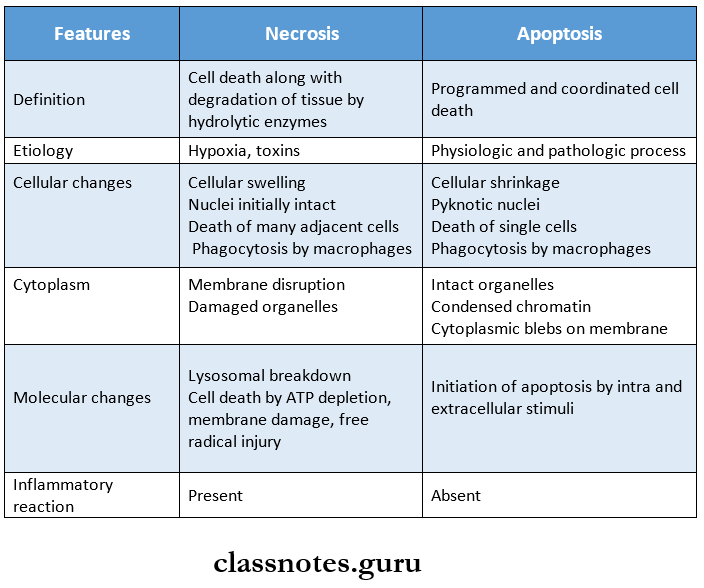
Morphology Of Cell Injury Short Question And Answers
Question 1. Irreversible cell injury
Answer:
- Cell injury is defined as a variety of stresses a cell en-. counters as a result of changes in its internal and external environment
- When such an injury is severe and persistent, cell death occurs
- Such an injury is called irreversible cell injury
Irreversible cell injury Features:
- The inability of the cell to reverse mitochondrial dysfunction
- Disturbance in cell membrane functions
- Reduction in ATP
- Continued depletion of proteins
- Reduced intracellular pH
- Leakage of lysosomal enzymes
Question 2. Etiology of cell injury
Answer:
Cell injury occurs due to the following causes:
1. Genetic causes
2. Acquired causes
- Hypoxia and ischemia
- Physical agents
- Chemical agents
- Microbial agents
- Nutritional derangements
- Immunologic agents
- Aging
- Iatrogenic factors
- Idiopathic
Question 3. Free radical injury
Answer:
- The free radical injury occurs in situations like ionizing radiation
- Oxygen free radicals are produced within the mitochondrial matrix
- They are:
- Superoxide
- Hydrogen peroxide
- Hydroxyl radical
Free radical injury Effects:
- Lipid peroxidation
- Oxidation of proteins
- DNA damage
- Cytoskeletal damage
Question 4. Reversible cell injury
Answer:
- Cell injury is defined as a variety of stresses a cell encounters as a result of changes in its internal and external environment
- When the stress is mild to moderate, the injured cell may recover, it is called reversible cell injury
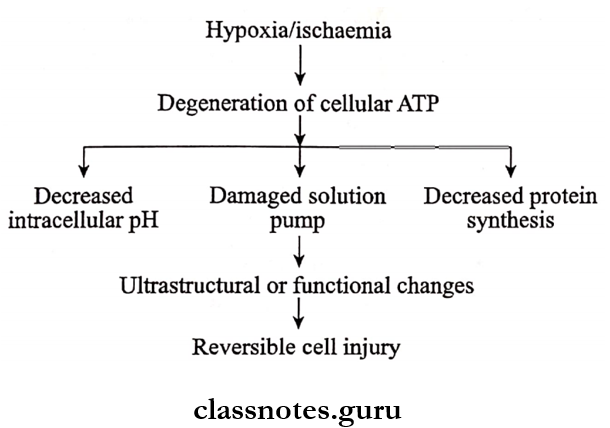
Question 5. Hyaline calcification
Answer:
- It describes the glassy, homogeneous, eosinophilic appearance of a material
- It is associated with pathological conditions that may be intracellular or extracellular
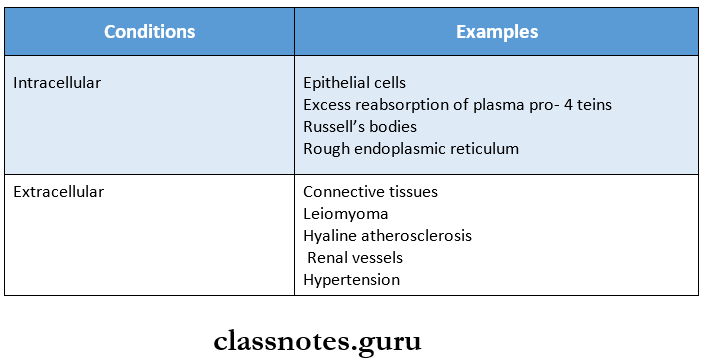
Question 6. Dystrophic and metastatic calcification.
Answer:
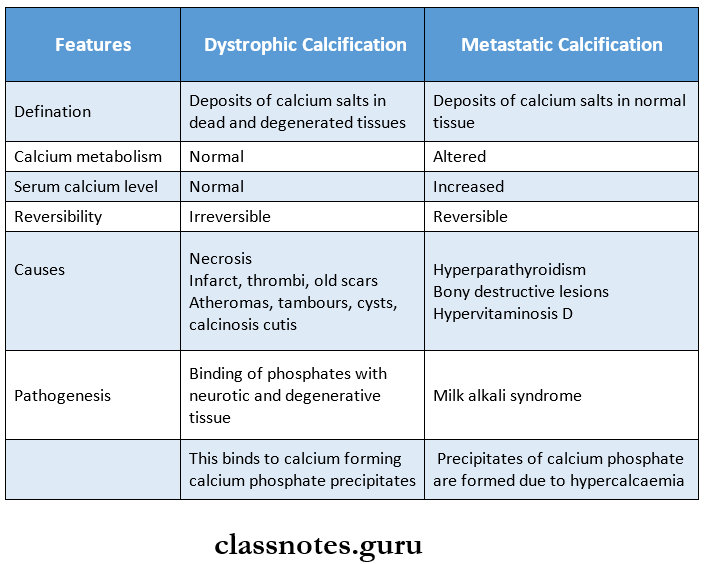
Question 7. Apoptosis
Answer:
Apoptosis is a form of coordinated and internally programmed cell death that has significance in a variety of physiologic and pathological conditions
1. Apoptosis in biological processes
- Organized cell destruction during the development of the embryo
- Physiologic involution of cells in hormone-dependent tissues
- Normal cell destruction
2. Pathologic process
- Cell death in tumors
- Cell death by cytotoxic T cells
- Cell death in viral infections
- Pathologic atrophy of organs
